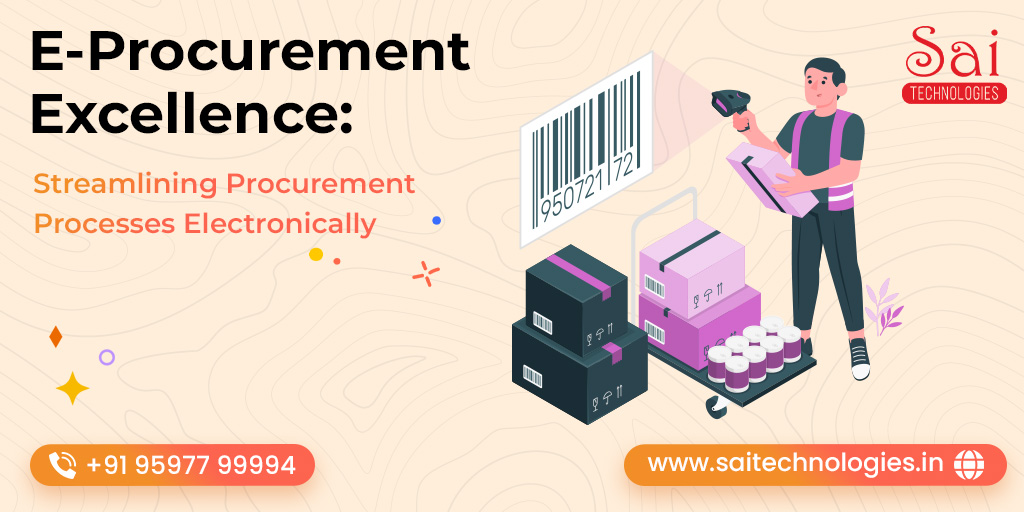E-Procurement Excellence
Streamlining Procurement Processes Electronically

Introduction
In today's fast-paced business environment, efficiency is essential. Organizations try to optimize all aspects of operations to remain competitive. One area that could be improved is the sales process. In the past, the procurement process was cumbersome, lengthy, manual paperwork, lengthy approval cycles and prone to errors. However, with the advent of e-procurement solutions, businesses have the opportunity to simplify their procurement processes electronically, thereby increasing efficiency, cost savings and greater transparency. In this article, we will dive deeper into the topic of e-procurement excellence, examining its benefits, implementation strategies, and best practices.
Advantages of e-commerce
- Electronic procurement offers many benefits to organizations of all sizes across a variety of industries.
- One of the biggest benefits is more energy, by digitizing procurement processes, companies can eliminate manual tasks such as paper and data entry, thereby saving time and resources.
- Automated workflows speed approvals, reduce turnaround times, and allow sales teams to focus on more strategic activities.
- Cost savings are another major benefit of e-shopping, By streamlining processes and increasing spending visibility, organizations can negotiate better terms with suppliers, identify cost savings opportunities, and eliminate unnecessary spending.
- In addition, e-procurementsolutions include many features such as spend analysis and supplier management, which allow organizations to make data-driven decisions that reduce costs and increase value.
Cost Savings:
On average, organizations can achieve cost savings ranging from 5% to 20% through the implementation of e-procurement solutions.
- In addition to increasing efficiency and cost savings, e-procurement increases transparency and compliance by storing contracts, purchase orders, and invoices, organizations can better understand their purchasing process.
- This transparency not only reduces the risk of errors and fraud but also ensures compliance with internal policies and external regulations.
- By tracking sales and approvals electronically, organizations can review their sales processes and demonstrate compliance to owners and managers.
Implementation Strategy
Implementing e-commerce solutions requires careful planning and execution to be successful.
Here are some key strategies to consider:
- Assess current processes: Before implementing an e-procurement system, organizations should conduct a thorough assessment of current procurement processes. Identify weak points, weaknesses, and areas for improvement so that you can choose the right solution.
- Set clear goals: Set goals and objectives for your e-commerce implementation, such as reducing cycle time, reducing costs, or improving compliance. Setting measurable goals helps track progress and ensure alignment with the organization's priorities.
- Choose the right solution: Choosing the right e-commerce solution is critical to success. Consider things like scalability, ease of use, integration capabilities, and customer reputation. Choose a solution that meets the unique needs of your organization and aligns with your long-term strategy.
Provide training and support:
- Ensure that employees receive appropriate training and support to use the e-procurement system effectively.
- Training courses, user guides, and ongoing support are provided to help users navigate the new system and maximize its benefits.
Monitor and evaluate effectiveness:
- Continuously monitor and evaluate the effectiveness of your e-procurement system based on defined metrics and KPIs.
- Solicit feedback from users and stakeholders to identify areas for improvement and make appropriate adjustments.
Best Practices for Excellence in eProcurement
To meet the importance of e-procurement, organizations must implement best practices to improve efficiency, transparency, and compliance.
Here are some good practices to consider:
Standardized processes:
- Standardize procurement processes and workflows to ensure consistency and efficiency across the organization.
- Organize tasks, responsibilities and approval lists to streamline the procurement process from proposal to payment.
Efficiency Improvements:
Studies show that e-procurement can reduce procurement cycle times by up to 50% and increase productivity by 25% to 50%.
- Data aggregation: Consolidate sales data into one repository to increase visibility and access. By bringing together contracts, purchase orders, invoices, and supplier information in one place, organizations can better understand their spending and make better decisions.
- Increase automation: Use automation to eliminate manual tasks and speed up the sales process. Use workflow automation to route purchase requests for approval, automatically generate purchase orders, and link invoices and purchase orders for payment processing.
- Implement supplier collaboration tools: Implement collaboration tools that enable communication and collaboration with suppliers. By sharing information and documents electronically, organizations can streamline procurement processes, reduce errors, and build stronger relationships with suppliers.
Supplier Collaboration:
Approximately 70% of organizations experience improved collaboration with suppliers after implementing e-procurement solutions, leading to better relationships and innovation opportunities.
- Use analytics: Use analytics to gain a deeper understanding of sales processes and identify areas for improvement. Use expense analysis tools to track spending patterns, identify cost savings opportunities, and negotiate better deals with suppliers.
Conclusion:
Excellence in e-procurement is essential for organizations seeking to optimize their procurement processes and increase their competitive advantage
Adoption Rate:
The global adoption rate of e-procurement solutions is projected to grow at a compound annual growth rate (CAGR) of around 10% between 2021 and 2026.

